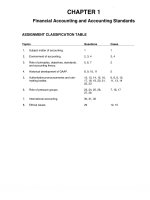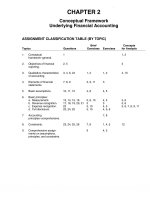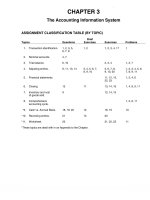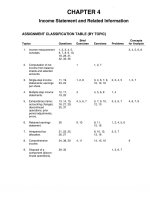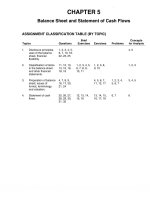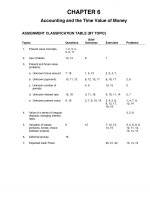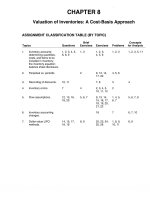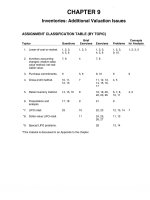Solution manual intermediate accounting 13e kieso ch16
Bạn đang xem bản rút gọn của tài liệu. Xem và tải ngay bản đầy đủ của tài liệu tại đây (425.61 KB, 68 trang )
To download more slides, ebook, solutions and test bank, visit
CHAPTER 16
Dilutive Securities and Earnings Per Share
ASSIGNMENT CLASSIFICATION TABLE (BY TOPIC)
Topics
Questions
Brief
Exercises
Exercises
Problems
Concepts
for Analysis
2
1
1.
Convertible debt
and preferred stock.
1, 2, 3, 4,
5, 6, 7, 28
1, 2, 3
1, 2, 3, 4, 5,
6, 7, 24, 25,
2.
Warrants and debt.
2, 3, 8, 9
4, 5
7, 8, 9, 28
3.
Stock options,
restricted stock.
1, 10, 11,
12, 13,
14, 15
6, 7, 8
10, 11, 12,
13, 14
4.
Earnings Per Share
(EPS)—terminology.
17, 18, 24
15
5.
EPS—Determining
potentially dilutive
securities.
19, 20, 21
12, 13, 14
6.
EPS—Treasury stock
method.
22, 23
7.
EPS—Weightedaverage computation.
15, 16
10, 11
8.
EPS—General
objectives.
24, 25
9, 15
9.
EPS—Comprehensive
calculations.
19, 20, 21,
22, 23, 24,
26, 27, 28
10.
EPS—Contingent
shares.
27
*11.
Stock appreciation
rights.
16
1, 3
1, 3, 4
2, 4
6
22, 23, 27
5, 7
28
5, 7
15, 16, 17,
18, 21
5, 6, 7,
8, 9
5, 6, 7
7, 8, 9
29, 30
*This material is dealt with in an Appendix to the chapter.
Copyright © 2010 John Wiley & Sons, Inc.
Kieso, Intermediate Accounting, 13/e, Solutions Manual
(For Instructor Use Only)
16-1
To download more slides, ebook, solutions and test bank, visit
ASSIGNMENT CLASSIFICATION TABLE (BY LEARNING OBJECTIVE)
Brief
Exercises
Exercises
Problems
1. Describe the accounting for the issuance,
conversion, and retirement of convertible
securities.
1, 2
2, 3, 4, 5, 6
1, 2
2. Explain the accounting for convertible
preferred stock.
3
24, 25
3. Contrast the accounting for stock warrants and for
stock warrants issued with other securities.
4, 5
1, 7, 8, 9
1
4. Describe the accounting for stock compensation
plans under generally accepted accounting
principles.
6, 7, 8
10, 11, 12,
13, 14
1, 3, 4
6. Compute earnings per share in a simple
capital structure
9, 10,
11, 15
15, 16, 17, 18,
19, 20, 21
6, 9
7. Compute earnings per share in a complex
capital structure.
12, 13, 14
22, 23, 24, 25,
26, 27, 28
5, 7, 8
16
29, 30
Learning Objectives
5. Discuss the controversy involving stock
compensation plans.
*8. Explain the accounting for stock-appreciation
rights plans.
*9. Compute earnings per share in
a complex situation.
16-2
Copyright © 2010 John Wiley & Sons, Inc.
Kieso, Intermediate Accounting, 13/e, Solutions Manual
(For Instructor Use Only)
To download more slides, ebook, solutions and test bank, visit
ASSIGNMENT CHARACTERISTICS TABLE
Item
Description
Level of
Difficulty
Time
(minutes)
E16-1
E16-2
E16-3
E16-4
E16-5
E16-6
E16-7
E16-8
E16-9
E16-10
E16-11
E16-12
E16-13
E16-14
E16-15
E16-16
E16-17
E16-18
E16-19
E16-20
E16-21
E16-22
E16-23
E16-24
E16-25
E16-26
E16-27
E16-28
*E16-29
*E16-30
Issuance and conversion of bonds.
Conversion of bonds.
Conversion of bonds.
Conversion of bonds.
Conversion of bonds.
Conversion of bonds.
Issuance of bonds with warrants.
Issuance of bonds with detachable warrants.
Issuance of bonds with stock warrants.
Issuance and exercise of stock options.
Issuance, exercise, and termination of stock options.
Issuance, exercise, and termination of stock options.
Accounting for restricted stock.
Accounting for restricted stock.
Weighted-average number of shares.
EPS: Simple capital structure.
EPS: Simple capital structure.
EPS: Simple capital structure.
EPS: Simple capital structure.
EPS: Simple capital structure.
EPS: Simple capital structure.
EPS with convertible bonds, various situations.
EPS with convertible bonds.
EPS with convertible bonds and preferred stock.
EPS with convertible bonds and preferred stock.
EPS with options, various situations.
EPS with contingent issuance agreement.
EPS with warrants.
Stock-appreciation rights.
Stock-appreciation rights.
Simple
Simple
Simple
Moderate
Simple
Moderate
Simple
Simple
Moderate
Moderate
Moderate
Moderate
Simple
Simple
Moderate
Simple
Simple
Simple
Simple
Simple
Simple
Complex
Moderate
Moderate
Moderate
Moderate
Simple
Moderate
Moderate
Moderate
15–20
15–20
10–15
15–20
10–20
25–35
10–15
10–15
15–20
15–25
15–25
15–25
10–15
10–15
15–25
10–15
10–15
10–15
20–25
10–15
10–15
20–25
15–20
20–25
10–15
20–25
10–15
15–20
15–25
15–25
P16-1
P16-2
P16-3
P16-4
P16-5
P16-6
P16-7
P16-8
P16-9
Entries for various dilutive securities.
Entries for conversion, amortization, and interest of bonds.
Stock option plan.
Stock-based compensation.
EPS with complex capital structure.
Basic EPS: Two-year presentation.
Computation of basic and diluted EPS.
Computation of basic and diluted EPS.
EPS with stock dividend and extraordinary items.
Moderate
Moderate
Moderate
Moderate
Moderate
Moderate
Moderate
Moderate
Complex
35–40
45–50
30–35
25–30
30–35
30–35
35–45
25–35
30–40
CA16-1
CA16-2
CA16-3
CA16-4
CA16-5
CA16-6
CA16-7
Warrants issued with bonds and convertible bonds.
Ethical issues—compensation plan.
Stock warrants—various types.
Stock compensation plans.
EPS: Preferred dividends, options, and convertible debt.
EPS concepts and effect of transactions on EPS.
EPS, antidilution.
Moderate
Simple
Moderate
Moderate
Moderate
Moderate
Moderate
20–25
15–20
15–20
25–35
25–35
25–35
25–35
Copyright © 2010 John Wiley & Sons, Inc.
Kieso, Intermediate Accounting, 13/e, Solutions Manual
(For Instructor Use Only)
16-3
To download more slides, ebook, solutions and test bank, visit
SOLUTIONS TO CODIFICATION EXERCISES
CE16-1
Master Glossary
(a)
The amount of earnings for the period available to each share of common stock outstanding during
the reporting period.
(b)
A reduction in EPS resulting from the assumption that convertible securities were converted, that
options or warrants were exercised, or that other shares were issued upon the satisfaction of certain
conditions.
(c)
A security that gives the holder the right to purchase shares of common stock in accordance with the
terms of the instrument, usually upon payment of a specified amount.
(d)
The date at which an employer and an employee reach a mutual understanding of the key terms and
conditions of a share-based payment award. The employer becomes contingently obligated on the
grant date to issue equity instruments or transfer assets to an employee who renders the requisite
service. Awards made under an arrangement that is subject to shareholder approval are not deemed to
be granted until that approval is obtained unless approval is essentially a formality (or perfunctory), for
example, if management and the members of the board of directors control enough votes to approve
the arrangement. Similarly, individual awards that are subject to approval by the board of directors,
management, or both are not deemed to be granted until all such approvals are obtained. The grant
date for an award of equity instruments is the date that an employee begins to benefit from, or be
adversely affected by, subsequent changes in the price of the employer’s equity shares. Paragraph
718-10-25-5 provides guidance on determining the grant date. See Service Inception Date.
CE16-2
According to FASB ASC 260-10-45-7 (Earnings Per Share—Other Presentation Matters):
EPS data shall be presented for all periods for which an income statement or summary of earnings is
presented. If diluted EPS data are reported for at least one period, they shall be reported for all periods
presented, even if they are the same amounts as basic EPS. If basic and diluted EPS are the same
amount, dual presentation can be accomplished in one line on the income statement.
CE16-3
According to FASB ASC 260-10-50-1 (Earnings Per Share—Disclosure):
For each period for which an income statement is presented, an entity shall disclose all of the following:
(a)
A reconciliation of the numerators and the denominators of the basic and diluted per-share computations for income from continuing operations. The reconciliation shall include the individual income and
share amount effects of all securities that affect earnings per share (EPS). Example 2 (see paragraph
260-10-55-51) illustrates that disclosure. (See paragraph 260-10-45-3.) An entity is encouraged to
refer to pertinent information about securities included in the EPS computations that is provided
elsewhere in the financial statements as prescribed by Subtopic 505-10.
(b)
The effect that has been given to preferred dividends in arriving at income available to common
stockholders in computing basic EPS.
16-4
Copyright © 2010 John Wiley & Sons, Inc.
Kieso, Intermediate Accounting, 13/e, Solutions Manual
(For Instructor Use Only)
To download more slides, ebook, solutions and test bank, visit
CE16-3 (Continued)
(c)
Securities (including those issuable pursuant to contingent stock agreements) that could potentially
dilute basic EPS in the future that were not included in the computation of diluted EPS because to do
so would have been antidilutive for the period(s) presented. Full disclosure of the terms and
conditions of these securities is required even if a security is not included in diluted EPS in the
current period.
CE16-4
According to FASB ASC 260-10-55-12 (Earnings Per Share—Implementation—Restatement of EPS Data):
If the number of common shares outstanding increases as a result of a stock dividend or stock split
(see Subtopic 505-20) or decreases as a result of a reverse stock split, the computations of basic and diluted
EPS shall be adjusted retroactively for all periods presented to reflect that change in capital structure.
If changes in common stock resulting from stock dividends, stock splits, or reverse stock splits occur after
the close of the period but before issuance of the financial statements, the per-share computations for
those and any prior-period financial statements presented shall be based on the new number of shares. If
per-share computations reflect such changes in the number of shares, that fact shall be disclosed.
Copyright © 2010 John Wiley & Sons, Inc.
Kieso, Intermediate Accounting, 13/e, Solutions Manual
(For Instructor Use Only)
16-5
To download more slides, ebook, solutions and test bank, visit
ANSWERS TO QUESTIONS
1.
Securities such as convertible debt or stock options are dilutive because their features indicate that
the holders of the securities can become common shareholders. When the common shares are
issued, there will be a reduction—dilution—in earnings per share.
2.
Corporations issue convertible securities for two reasons. One is to raise equity capital without giving
up more ownership control than necessary. A second reason is to obtain financing at cheaper rates.
The conversion privilege attracts investors willing to accept a lower interest rate than on a straight
debt issue.
3.
Convertible debt and debt issued with stock warrants are similar in that: (1) both allow the issuer to
issue debt at a lower interest cost than would generally be available for straight debt; (2) both allow
the holders to purchase the issuer’s stock at less than market value if the stock appreciates
sufficiently in the future; (3) both provide the holder the protection of a debt security if the value of the
stock does not appreciate; and (4) both are complex securities which contain elements of debt and
equity at the time of issue.
Convertible debt and debt with stock warrants are different in that: (1) if the market price of the stock
increases sufficiently, the issuer can force conversion of convertible debt into common stock by
calling the issue for redemption, but the issuer cannot force exercise of the warrants; (2) convertible
debt may be essentially equity capital, whereas debt with stock warrants is debt with the additional
right to acquire equity; and (3) the conversion option and the convertible debt are inseparable and, in
the absence of separate transferability, do not have separate values established in the market;
whereas debt with detachable stock warrants can be separated into debt and the right to purchase
stock, each having separate values established by the transactions in the market.
4.
The accounting treatment of the $160,000 “sweetener” to induce conversion of the bonds into common
shares represents a departure from GAAP because the FASB views the transaction as the retirement
of debt. Therefore, the FASB requires that the “sweetener” of $160,000 be reported as an expense.
It is not an extraordinary loss because it is simply a payment to induce conversion.
5.
(a) From the point of view of the issuer, the conversion feature of convertible debt results in a lower
cash interest cost than in the case of nonconvertible debt. In addition, the issuer in planning its
long-range financing may view the convertible debt as a means of raising equity capital over the
long term. Thus, if the market value of the underlying common stock increases sufficiently after
the issue of the debt, the issuer will usually be able to force conversion of the convertible debt
into common stock by calling the issue for redemption. Under the market conditions, the issuer
can effectively eliminate the debt. On the other hand, if the market value of the common
stock does not increase sufficiently to result in the conversion of the debt, the issuer will have
received the benefit of the cash proceeds to the scheduled maturity dates at a relatively low
cash interest cost.
(b)
16-6
The purchaser obtains an option to receive either the face amount of the debt upon maturity or
the specified number of common shares upon conversion. If the market value of the underlying
common stock increases above the conversion price, the purchaser (either through conversion
or through holding the convertible debt containing the conversion option) receives the benefits of
appreciation. On the other hand, should the value of the underlying company stock not increase,
the purchaser could nevertheless expect to receive the principal and (lower) interest.
Copyright © 2010 John Wiley & Sons, Inc.
Kieso, Intermediate Accounting, 13/e, Solutions Manual
(For Instructor Use Only)
To download more slides, ebook, solutions and test bank, visit
Questions Chapter 16 (Continued)
6.
The view that separate accounting recognition should be accorded the conversion feature of
convertible debt is based on the premise that there is an economic value inherent in the conversion
feature or call on the common stock and that the value of this feature should be recognized for
accounting purposes by the issuer. It may be argued that the call is not significantly different in nature
from the call contained in an option or warrant and its issue is thus a type of capital transaction. The
fact that the conversion feature coexists with certain senior security characteristics in a complex
security and cannot be physically separated from these elements or from the instrument does not
constitute a logical or compelling reason why the values of the various elements should not receive
separate accounting recognition. The fact that the eventual outcome of the option granted the
purchaser of the convertible debt cannot be determined at date of issuance is not relevant to
the question of effectively reflecting in the accounting records the various elements of the complex
document at the date of issuance. The conversion feature has a value at date of issuance and should
be recognized. Moreover, the difficulties of implementation are not insurmountable and should not be
relied upon to govern the conclusion.
7.
The method used by the company to record the exchange of convertible debentures for common
stock can be supported on the grounds that when the company issued the convertible debentures,
the proceeds could represent consideration received for the stock. Therefore, when conversion
occurs, the book value of the obligation is simply transferred to the stock exchanged for it. Further
justification is that conversion represents a transaction with stockholders which should not give rise to
a gain or loss.
On the other hand, recording the issue of the common stock at the book value of the debentures is
open to question. It may be argued that the exchange of the stock for the debentures completes
the transaction cycle for the debentures and begins a new cycle for the stock. The consideration or
value used for this new transaction cycle should then be the amount which would be received if the
debentures were sold rather than exchanged, or the amount which would be received if the related
stock were sold, whichever is more clearly determinable at the time of the exchange. This method
recognizes changes in values which have occurred and subordinates a consideration determined at
the time the debentures were issued.
8.
Cash ................................................................................................................
Discount on Bonds Payable........................................................................
Bonds Payable .....................................................................................
Paid-in Capital—Stock Warrants ......................................................
Value of bonds with warrants
Value of warrants
Value of bonds without warrants
3,000,000
100,000
3,000,000
100,000
$3,000,000
100,000
$2,900,000
In this case, the incremental method is used since no separate value is given for the bonds without
the warrants.
9.
If a corporation decides to issue new shares of stock, the old stockholders generally have the right,
referred to as a stock right, to purchase newly issued shares in proportion to their holdings. No entry
is required when rights are issued to existing stockholders. Only a memorandum entry is needed to
indicate that the rights have been issued. If exercised, the corporation simply debits Cash for the
proceeds received, credits Common Stock for the par value, and any difference is recorded with
a credit to Paid-in Capital in Excess of Par.
10.
Companies are required to use the fair value method to recognize compensation cost. For most stock
option plans compensation cost is measured at the grant date and allocated to expense over the
service period, which typically ends on the vesting date.
Copyright © 2010 John Wiley & Sons, Inc.
Kieso, Intermediate Accounting, 13/e, Solutions Manual
(For Instructor Use Only)
16-7
To download more slides, ebook, solutions and test bank, visit
Questions Chapter 16 (Continued)
11.
This plan would not be considered compensatory since it meets the conditions of a noncompensatory
plan; i.e., (1) substantially all full-time employees may participate on an equitable basis, (2) the
discount from market price is small, and (3) the plan offers no substantive option feature.
12.
The profession recommends that the fair value of a stock option be determined on the date on which
the option is granted to a specific individual.
At the date the option is granted, the corporation foregoes the alternative of selling the shares at the
then prevailing price. The market price on the date of grant may be presumed to be the value which
the employer had in mind. It is the value of the option at the date of grant, rather than the grantor’s
ultimate gain or loss on the transaction, which for accounting purposes constitutes whatever compensation the grantor intends to pay.
13.
GAAP requires that compensation expense be recognized over the service period. Unless otherwise
specified, the service period is the vesting period—the time between the grant date and the vesting
date.
14.
Using the fair value approach, total compensation expense is computed based on the fair value of
the options on the date the options are granted to the employees. Fair value is estimated using an
acceptable option pricing model (such as the Black-Scholes option-pricing model).
15.
The advantages of using restricted stock to compensate employees are: (1) The restricted stock
never becomes completely worthless; (2) it generally results in less dilution than stock options; and
(3) it better aligns the employee incentives with the companies incentives.
16.
Weighted-average shares outstanding
Outstanding shares (all year) =..................................................................
October 1 to December 31 (200,000 X 1/4) =.........................................
Weighted average.........................................................................................
Net income ..............................................................................................................
Preferred dividends................................................................................................
Income available to common stockholders.......................................................
Earnings per share =
$1,600,000
450,000
400,000
50,000
450,000
$2,000,000
400,000
$1,600,000
= $3.56
17.
The computation of the weighted-average number of shares requires restatement of the shares
outstanding before the stock dividend or split. The additional shares outstanding as a result of a stock
dividend or split are assumed to have been outstanding since the beginning of the year. Shares
outstanding prior to the stock dividend or split are adjusted so that these shares are stated on the
same basis as shares issued after the stock dividend/split.
18.
(a) Basic earnings per share is the amount of earnings for the period available to each share of
common stock outstanding during the reporting period.
16-8
(b)
A potentially dilutive security is a security which can be exchanged for or converted into common
stock and therefore upon conversion or exercise could dilute (or decrease) earnings per share.
Included in this category are convertible securities, options, warrants, and other rights.
(c)
Diluted earnings per share is the amount of earnings for the period available to each share of
common stock outstanding and to each share that would have been outstanding assuming the
issuance of common shares for all dilutive potential common shares outstanding during the
reporting period.
Copyright © 2010 John Wiley & Sons, Inc.
Kieso, Intermediate Accounting, 13/e, Solutions Manual
(For Instructor Use Only)
To download more slides, ebook, solutions and test bank, visit
Questions Chapter 16 (Continued)
(d)
A complex capital structure exists whenever a company’s capital structure includes dilutive
securities.
(e)
Potential common stock is not common stock in form but does enable its holders to obtain
common stock upon exercise or conversion.
19.
Convertible securities are potentially dilutive securities and part of diluted earnings per share if their
conversion increases the EPS numerator less than it increases the EPS denominator; i.e., the EPS
with conversion is less than the EPS before conversion.
20.
The concept that a security may be the equivalent of common stock has evolved to meet the
reporting needs of investors in corporations that have issued certain types of convertible securities,
options, and warrants. A potentially dilutive security is a security which is not, in form, common stock
but which enables its holder to obtain common stock upon exercise or conversion. The holders of
these securities can expect to participate in the appreciation of the value of the common stock resulting
principally from the earnings and earnings potential of the issuing corporation. This participation is
essentially the same as that of a common stockholder except that the security may carry a specified
dividend yielding a return different from that received by a common stockholder. The attractiveness to
investors of this type of security is often based principally upon this potential right to share in increases
in the earnings potential of the issuing corporation rather than upon its fixed return or upon other
senior security characteristics. In addition, the call characteristic of the stock options and warrants gives
the investor potential control over a far greater number of shares per dollar of investment than if the
investor owned the shares outright.
21.
Convertible securities are considered to be potentially dilutive securities whenever their conversion
would decrease earnings per share. If this situation does not result, conversion is not assumed and
only basic EPS is reported.
22.
Under the treasury-stock method, diluted earnings per share should be determined as if outstanding
options and warrants were exercised at the beginning of year (or date of issue if later) and the funds
obtained thereby were used to purchase common stock at the average market price for the period.
For example, if a corporation has 10,000 warrants outstanding exercisable at $54, and the average
market price of the common stock during the reported period is $60, the $540,000 which would be
realized from exercise of warrants and issuance of 10,000 shares would be an amount sufficient to
acquire 9,000 shares; thus, 1,000 shares would be added to the outstanding common shares in
computing diluted earnings per share for the period. However, to avoid an incremental positive effect
upon earnings per share, options and warrants should enter into the computation only when the
average market price of the common stock exceeds the exercise price of the option or warrant.
23.
Yes, if warrants or options are present, an increase in the market price of the common stock can
increase the number of potentially dilutive common shares by decreasing the number of shares
repurchasable. In addition, an increase in the market price of common stock can increase the
compensation expense reported in a stock-appreciation rights plan. This would decrease net income
and, consequently, earnings per share.
24.
Antidilution is an increase in earnings per share resulting from the assumption that convertible
securities have been converted or that options and warrants have been exercised, or other shares
have been issued upon the fulfillment of certain conditions. For example, an antidilutive condition
would exist when the dividend or interest requirement (net of tax) of a convertible security exceeds
the current EPS multiplied by the number of common shares issuable upon conversion of the
security. This may be illustrated by assuming a company in the following situation:
Net income .................................................................................................................................
Outstanding shares of common stock ..................................................................................
6% Bonds payable (convertible into 5,000 shares of common stock)............................
Tax rate.......................................................................................................................................
$ 10,000
20,000
$100,000
40%
Basic earnings per share = $10,000/20,000 shares = $.50
Copyright © 2010 John Wiley & Sons, Inc.
Kieso, Intermediate Accounting, 13/e, Solutions Manual
(For Instructor Use Only)
16-9
To download more slides, ebook, solutions and test bank, visit
Questions Chapter 16 (Continued)
Earnings per share assuming conversion of the bonds:
Net income ........................................................................................................................
Bond interest (net of tax) = (1 – .40) ($100,000 X .06).............................................
Adjusted net income........................................................................................................
Earnings per share assuming conversion =
$13,600
20,000 + 5,000
$10,000
3,600
$13,600
= $.54
This antidilutive effect occurs because the bond interest (net of tax) of $3,600 is greater than the
current EPS of $.50 multiplied by the number of shares issuable upon conversion of the bonds (5,000
shares).
25.
Both basic earnings per share and diluted earnings per share must be presented in a complex
capital structure. When irregular items are reported, per share amounts should be shown for income
from continuing operations, income before extraordinary items, and net income.
26.
The primary iGAAP reporting standards related to financial instruments, including dilutive securities
is IAS 39 “Financial Instruments: Recognition and Measurement”. The accounting for various forms
of stock-based compensation under iGAAP is found in IFRS 2 “Share-Based Payment”. This standard
was recently amended, resulting in significant convergence between iGAAP and U.S. GAAP in this
area. The iGAAP standard addressing accounting and reporting for earnings per share computations
in IAS 33 “Earnings per Share”.
27.
iGAAP and U.S. GAAP are substantially the same in the accounting for dilutive securities, stockbased compensation, and earnings per share. For example, both iGAAP and U.S. GAAP follow the
same model for recognizing stock-based compensation. That is, the fair value of shares and options
awarded to employees is recognized over the period to which the employees’ services relate.
The main differences concern (1) the accounting for convertible debt. Under U.S. GAAP all of the
proceeds of convertible debt are recorded as long term debt. Under iGAAP, convertible bonds are
“bifurcated”, or separated into the equity component—the value of the conversion option—of the
bond issue and the debt component; (2) a minor differences in EPS reporting—the FASB allows
companies to rebut the presumption that contracts that can be settled in either cash or shares will be
settled in shares. iGAAP requires that share settlement must be used in this situation; (3) other EPS
differences relate to the treasury stock method and how the proceeds from extinguishment of
a liability should be accounted for and how to make the computation for the weighted-average of
contingently issuable shares.
28.
(a) Norman makes the following entry to record the issuance under U.S. GAAP.
Cash .................................................................................................................................
Bonds payable..........................................................................................................
(b)
16-10
400,000
Under iGAAP, Norman must “bifurcate” (split out) the equity component—the value of the
conversion option—of the bond issue. Under iGAAP, the convertible bond issue is recorded as
follows.
Cash .................................................................................................................................
Discount on Bonds Payable.........................................................................................
Bonds Payable .........................................................................................................
Paid-in Capital—Convertible Bonds.....................................................................
(c)
400,000
400,000
35,000
400,000
35,000
iGAAP provides a more faithful representation of the impact of the bond issue, by recording
separately its debt and equity components. However, there are concerns about reliability of the
models used to estimate the equity portion of the bond issue.
Copyright © 2010 John Wiley & Sons, Inc.
Kieso, Intermediate Accounting, 13/e, Solutions Manual
(For Instructor Use Only)
To download more slides, ebook, solutions and test bank, visit
Questions Chapter 16 (Continued)
29.
The FASB has been working on a standard that will likely converge to iGAAP in the accounting for
convertible debt. Similar to the FASB the IASB is examining the classification of hybrid securities;
the IASB is seeking comment on a discussion document similar to the FASB Preliminary Views
document: “Financial Instruments with Characteristics of Equity.” It is hoped that the boards will
develop a converged standard in this area. While U.S. GAAP and iGAAP are similar as to the
presentation of EPS, the Boards have been working together to resolve remaining differences
related to earnings per share computations.
*30.
Antidilution when multiple securities are involved is determined by ranking the securities for
maximum possible dilution in terms of per share effect. Starting with the most dilutive, earnings per
share is reduced until one of the securities maintains or increases earnings per share. When an
increase in earnings per share occurs, the security that causes the increase in earnings per share is
excluded. The previous computation therefore provided the maximum dilution.
Copyright © 2010 John Wiley & Sons, Inc.
Kieso, Intermediate Accounting, 13/e, Solutions Manual
(For Instructor Use Only)
16-11
To download more slides, ebook, solutions and test bank, visit
SOLUTIONS TO BRIEF EXERCISES
BRIEF EXERCISE 16-1
Cash...........................................................................................
Discount on Bonds Payable ..............................................
Bonds Payable ..............................................................
3,960,000
40,000
4,000,000
BRIEF EXERCISE 16-2
Bonds Payable .......................................................................
Discount on Bonds Payable .....................................
Common Stock (2,000 X 50 X $10)..........................
Paid-in Capital in Excess of Par ..............................
2,000,000
30,000
1,000,000
970,000
BRIEF EXERCISE 16-3
Preferred Stock (1,000 X $50)............................................
Paid-in Capital in Excess of Par—Preferred
Stock ($60 – $50) X 1,000 ...............................................
Common Stock (2,000 X $10) ...................................
Paid-in Capital in Excess of Par—
Common Stock
($60 X 1,000) – (2,000 X $10) ................................
50,000
10,000
20,000
40,000
BRIEF EXERCISE 16-4
Cash...........................................................................................
Discount on Bonds Payable
($2,000,000 – $1,940,784) ...............................................
Bonds Payable ..............................................................
Paid-in Capital—Stock Warrants.............................
2,020,000
59,216
2,000,000
79,216
FMV of bonds (2,000 X $1,000 X .98)...............................
FMV of warrants (2,000 X $40) ..........................................
Aggregate FMV.......................................................................
$1,960,000
80,000
$2,040,000
Allocated to bonds ($1,960/$2,040 X $2,020,000) .......
Allocated to warrants ($80/$2,040 X $2,020,000) ........
$1,940,784
79,216
$2,020,000
16-12
Copyright © 2010 John Wiley & Sons, Inc.
Kieso, Intermediate Accounting, 13/e, Solutions Manual
(For Instructor Use Only)
To download more slides, ebook, solutions and test bank, visit
BRIEF EXERCISE 16-5
Cash .......................................................................................
Discount on Bonds Payable
[$2,000,000 X (1 – .98)].................................................
Bonds Payable...........................................................
Paid-in Capital—Stock Warrants .........................
2,020,000
40,000
2,000,000
60,000*
*$2,000,000 X (1.01 – .98)
BRIEF EXERCISE 16-6
1/1/10
No entry
12/31/10
Compensation Expense.............................
Paid-in Capital—Stock
Options ..............................................
75,000
Compensation Expense.............................
Paid-in Capital—Stock
Options ..............................................
75,000
12/31/11
75,000
75,000
BRIEF EXERCISE 16-7
1/1/10
12/31/10
12/31/11
Unearned Compensation ..........................
Common Stock (2,000 X $5) ............
Paid in Capital in Excess of Par
[($65 – $5) X 2,000] ..........................
130,000
Compensation Expense.............................
Unearned Compensation..................
65,000
Compensation Expense.............................
Unearned Compensation..................
65,000
Copyright © 2010 John Wiley & Sons, Inc.
Kieso, Intermediate Accounting, 13/e, Solutions Manual
10,000
120,000
65,000
65,000
(For Instructor Use Only)
16-13
To download more slides, ebook, solutions and test bank, visit
BRIEF EXERCISE 16-8
1/1/10
12/31/10
Unearned Compensation...................................
Common Stock .................................................
Paid-in Capital in Excess of Par..................
75,000
Compensation Expense.....................................
Unearned Compensation ($75,000 ÷ 3).....
25,000
10,000
65,000
25,000
BRIEF EXERCISE 16-9
$1,000,000 – (100,000 X $2)
= $3.20 per share
250,000 shares
BRIEF EXERCISE 16-10
Dates
Outstanding
Shares
Outstanding
Fraction
of Year
Weighted
Shares
1/1–5/1
5/1–7/1
7/1–10/1
10/1–12/31
120,000
180,000
170,000
180,000
4/12
2/12
3/12
3/12
40,000
30,000
42,500
45,000
157,500
BRIEF EXERCISE 16-11
(a) (300,000 X 4/12) + (330,000 X 8/12) = 320,000
(b) 330,000 (The 30,000 shares issued in the stock dividend are assumed
outstanding from the beginning of the year.)
BRIEF EXERCISE 16-12
Net income.................................................................................................
Adjustment for interest, net of tax [$80,000 X (1 – .40)] .............
Adjusted net income ..............................................................................
Weighted average number of shares adjusted for
dilutive securities (100,000 + 16,000) ...........................................
Diluted EPS ...............................................................................................
16-14
Copyright © 2010 John Wiley & Sons, Inc.
Kieso, Intermediate Accounting, 13/e, Solutions Manual
$300,000
48,000
$348,000
÷116,000
$3.00
(For Instructor Use Only)
To download more slides, ebook, solutions and test bank, visit
BRIEF EXERCISE 16-13
Net income ................................................................................................
Weighted average number of shares adjusted
for dilutive securities (50,000 + 10,000) ......................................
Diluted EPS ...............................................................................................
$270,000
÷ 60,000
$4.50
BRIEF EXERCISE 16-14
Proceeds from assumed exercise of 45,000
options (45,000 X $10) ......................................................................
Shares issued upon exercise .............................................................
Treasury shares purchasable ($450,000 ÷ $15) ............................
Incremental shares.................................................................................
Diluted EPS =
$300,000
=
200,000 + 15,000
$450,000
45,000
30,000
15,000
$1.40
BRIEF EXERCISE 16-15
Earnings per share
Income before extraordinary loss ($600,000/100,000).......
Extraordinary loss ($120,000/100,000)....................................
Net income ($480,000/100,000)..................................................
$ 6.00
(1.20)
$ 4.80
*BRIEF EXERCISE 16-16
2010:
(5,000 X $4) X 50% = $10,000
2011:
(5,000 X $9) – $10,000 = $35,000
Copyright © 2010 John Wiley & Sons, Inc.
Kieso, Intermediate Accounting, 13/e, Solutions Manual
(For Instructor Use Only)
16-15
To download more slides, ebook, solutions and test bank, visit
SOLUTIONS TO EXERCISES
EXERCISE 16-1 (15–20 minutes)
1.
2.
Cash ($10,000,000 X .99) .....................................
Discount on Bonds Payable ..............................
Bonds Payable ...............................................
9,900,000
100,000
Unamortized Bond Issue Costs........................
Cash...................................................................
70,000
Cash...........................................................................
Discount on Bonds Payable ..............................
Bonds Payable ...............................................
Paid-in Capital—Stock Warrants..............
9,800,000
600,000
Value of bonds
plus warrants
($10,000,000 X .98)
Value of warrants
(100,000 X $4)
Value of bonds
3.
10,000,000
70,000
10,000,000
400,000
$9,800,000
400,000
$9,400,000
Debt Conversion Expense..................................
Bonds Payable .......................................................
Discount on Bonds Payable ......................
Common Stock...............................................
Paid-in Capital in Excess of Par ...............
Cash...................................................................
75,000
10,000,000
55,000
1,000,000
8,945,000*
75,000
*[($10,000,000 – $55,000) – $1,000,000]
EXERCISE 16-2 (15–20 minutes)
(a) Interest Payable ($150,000 X 2/6) .....................
Interest Expense ($150,000 X 4/6) + $2,032 .....
Discount on Bonds Payable ......................
Cash ($3,000,000 X 10% ÷ 2)......................
50,000
102,032
2,032
150,000
Calculations:
Par value
Issuance price
Total discount
16-16
Copyright © 2010 John Wiley & Sons, Inc.
$3,000,000
2,940,000
$ 60,000
Kieso, Intermediate Accounting, 13/e, Solutions Manual
(For Instructor Use Only)
To download more slides, ebook, solutions and test bank, visit
EXERCISE 16-2 (Continued)
Months remaining
Discount per month
($60,000 ÷ 118)
Discount amortized
(4 X $508)
118
$508
$2,032
(b) Bonds Payable..............................................................
Discount on Bonds Payable..............................
Common Stock (30,000 X $20) .........................
Paid-in Capital in Excess of Par ......................
1,000,000
18,305
600,000
381,695*
*($1,000,000 – $18,305) – $600,000
Calculations:
Discount related to 1/3 of
the bonds ($60,000 X 1/3)
Less: Discount amortized
[($60,000 ÷ 118) X 10 X 1/3]
Unamortized bond discount
$20,000
1,695
$18,305
EXERCISE 16-3 (10–15 minutes)
Conversion recorded at book value of the bonds:
Bonds Payable.......................................................................
Premium on Bonds Payable..............................................
Preferred Stock (400 X 20 X $50) ............................
Paid-in Capital in Excess of ParPreferred Stock ........................................................
400,000
6,000
400,000
6,000
EXERCISE 16-4 (15–20 minutes)
(a) Cash .................................................................................
Bonds Payable.....................................................
Premium on Bonds Payable............................
(To record issuance of $10,000,000
of 8% convertible debentures for
$10,600,000. The bonds mature
in twenty years, and each $1,000
bond is convertible into five shares
of $30 par value common stock)
Copyright © 2010 John Wiley & Sons, Inc.
Kieso, Intermediate Accounting, 13/e, Solutions Manual
10,600,000
10,000,000
600,000
(For Instructor Use Only)
16-17
To download more slides, ebook, solutions and test bank, visit
EXERCISE 16-4 (Continued)
(b) Bonds Payable .......................................................
Premium on Bonds Payable
(Schedule 1) .......................................................
Common Stock, $15 par
(Schedule 2) ..............................................
Paid-in Capital in Excess of Par ..............
(To record conversion of 20%
of the outstanding 8% convertible
debentures after giving effect
to the 2-for-1 stock split)
2,000,000
108,000
300,000
1,808,000
Schedule 1
Computation of Unamortized Premium on Bonds Converted
Premium on bonds payable on January 1, 2010..............
Amortization for 2010 ($600,000 ÷ 20) .................................
Amortization for 2011 ($600,000 ÷ 20) .................................
Premium on bonds payable on January 1, 2012..............
Bonds converted ........................................................................
Unamortized premium on bonds converted .....................
$600,000
$30,000
30,000
60,000
540,000
20%
$108,000
Schedule 2
Computation of Common Stock Resulting from Conversion
Number of shares convertible on January 1, 2010:
Number of bonds ($10,000,000 ÷ $1,000)......................
Number of shares for each bond.....................................
Stock split on January 1, 2011..............................................
Number of shares convertible after the stock split .......
% of bonds converted..............................................................
Number of shares issued .......................................................
Par value/per share...................................................................
Total par value............................................................................
16-18
Copyright © 2010 John Wiley & Sons, Inc.
10,000
X
5
Kieso, Intermediate Accounting, 13/e, Solutions Manual
50,000
X
2
100,000
X
20%
20,000
$15
$300,000
(For Instructor Use Only)
To download more slides, ebook, solutions and test bank, visit
EXERCISE 16-5 (10–20 minutes)
Interest Expense .......................................................................
Discount on Bonds Payable
[$10,240 ÷ 64 = $160; $160 X 4]...............................
Cash (10% X $600,000 X 1/2) ........................................
(Assumed that the interest accrual was
reversed as of January 1, 2011; if the interest
accrual was not reversed, interest expense
would be $20,640 and interest payable would
be debited for $10,000)
30,640
Bonds Payable...........................................................................
Discount on Bonds Payable ($10,240 – $640) ........
Common Stock ($25 X 6 X 600) ...................................
Paid-in Capital in Excess of Par..................................
600,000
640
30,000
9,600
90,000
500,400*
*($600,000 – $9,600) – $90,000
EXERCISE 16-6 (25–35 minutes)
(a)
(b)
December 31, 2010
Bond Interest Expense...................................................
Premium on Bonds Payable
($60,000 X 1/20)...........................................................
Cash ($3,000,000 X 8% X 6/12)............................
January 1, 2011
Bonds Payable..................................................................
Premium on Bonds Payable.........................................
Common Stock
[8 X $100 X ($600,000/$1,000)].......................
Paid-in Capital in Excess of Par.........................
Total premium
($3,000,000 X .02)
Premium amortized
($60,000 X 2/10)
Balance
Bonds converted
($600,000 ÷ $3,000,000)
Related premium
($48,000 X 20%)
Copyright © 2010 John Wiley & Sons, Inc.
117,000
3,000
120,000
600,000
9,600
480,000
129,600
$60,000
12,000
$48,000
20%
9,600
Kieso, Intermediate Accounting, 13/e, Solutions Manual
(For Instructor Use Only)
16-19
To download more slides, ebook, solutions and test bank, visit
EXERCISE 16-6 (Continued)
(c)
March 31, 2011
Bond Interest Expense ...................................................
Premium on Bonds Payable
($9,600 ÷ 8 years) X 3/12...........................................
Bond Interest Payable
($600,000 X 8% X 3/12) ......................................
March 31, 2011
Bonds Payable ..................................................................
Premium on Bonds Payable .........................................
Common Stock.........................................................
Paid-in Capital in Excess of Par .........................
Premium as of January 1, 2011
for $600,000 of bonds
$9,600 ÷ 8 years remaining
X 3/12
Premium as of March 31, 2011
for $600,000 of bonds
(d)
11,700
300
12,000
600,000
9,300
480,000
129,300
$9,600
(300)
$9,300
June 30, 2011
Bond Interest Expense ...................................................
Premium on Bonds Payable .........................................
Bond Interest Payable
($600,000 X 8% X 1/4)***.............................................
Cash.............................................................................
70,200
1,800
12,000
84,000*
[Premium to be amortized:
($60,000 X 60%) X 1/20 = $1,800, or
$28,800** ÷ 16 (remaining interest and
amortization periods) = $1,800]
*Total to be paid: ($1,800,000 X 8% ÷ 2) + $12,000 = $84,000
**Original premium
2009 amortization
2010 amortization
Jan. 1, 2011 write-off
Mar. 31, 2011 amortization
Mar. 31, 2011 write-off
$60,000
(6,000)
(6,000)
(9,600)
(300)
(9,300)
$28,800
***Assumes interest accrued on March 31. If not, debit Bond Interest
Expense for $82,200.
16-20
Copyright © 2010 John Wiley & Sons, Inc.
Kieso, Intermediate Accounting, 13/e, Solutions Manual
(For Instructor Use Only)
To download more slides, ebook, solutions and test bank, visit
EXERCISE 16-7 (10–15 minutes)
(a) Basic formulas:
Value of bonds without warrants
X Issue price = Value assigned to bonds
Value of bonds without warrants
+ Value of warrants
Value of warrants
X Issue price = Value assigned to warrants
Value of bonds without warrants
+ Value of warrants
$136,000
$136,000 + $24,000
X $150,000 = $127,500
Value assigned to bonds
$24,000
$136,000 + $24,000
X $150,000 = $22,500
$150,000
Value assigned to warrants
Total
Cash .....................................................................................
Discount on Bonds Payable
($175,000 – $127,500) .................................................
Bonds Payable.........................................................
Paid-in Capital—Stock Warrants .......................
150,000
47,500
175,000
22,500
(b) When the warrants are non-detachable, separate recognition is not given
to the warrants. The accounting treatment parallels that given convertible
debt because the debt and equity element cannot be separated.
The entry if warrants were non-detachable is:
Cash .....................................................................................
Discount on Bonds Payable.........................................
Bonds Payable.........................................................
Copyright © 2010 John Wiley & Sons, Inc.
Kieso, Intermediate Accounting, 13/e, Solutions Manual
150,000
25,000
175,000
(For Instructor Use Only)
16-21
To download more slides, ebook, solutions and test bank, visit
EXERCISE 16-8 (10–15 minutes)
JACOB COMPANY
Journal Entry
September 1, 2010
Cash ($3,120,000 + $60,000 – $30,000).......................
Unamortized Bond Issue Costs....................................
Bonds Payable (3,000 X $1,000) ..........................
Premium on Bonds Payable—Schedule 1 .......
Paid-in Capital—Stock Warrants—
Schedule 1..............................................................
Bond Interest Expense—Schedule 2 .................
(To record the issuance of the bonds)
3,150,000
30,000
3,000,000
102,000
18,000
60,000
Schedule 1
Premium on Bonds Payable and Value of Stock Warrants
Sales price (3,000 X $1,040) ...............................................................
Face value of bonds .............................................................................
Deduct value assigned to stock warrants
(3,000 X 2 = 6,000; 6,000 X $3) ........................................................
Premium on bonds payable...............................................................
$3,120,000
3,000,000
120,000
18,000
$ 102,000
Schedule 2
Accrued Bond Interest to Date of Sale
Face value of bonds .............................................................................
Interest rate .............................................................................................
Annual interest.......................................................................................
$3,000,000
8%
$ 240,000
Accrued interest for 3 months – ($240,000 X 3/12) ....................
$
60,000
EXERCISE 16-9 (15–20 minutes)
(a) Cash ($3,000,000 X 1.02) ................................
Discount on Bonds Payable
[(1 – .98) X $3,000,000].................................
Bonds Payable ............................................
Paid-in Capital—Stock Warrants...........
3,060,000
60,000
3,000,000
120,000*
*$3,060,000 – ($3,000,000 X .98)
16-22
Copyright © 2010 John Wiley & Sons, Inc.
Kieso, Intermediate Accounting, 13/e, Solutions Manual
(For Instructor Use Only)
To download more slides, ebook, solutions and test bank, visit
EXERCISE 16-9 (Continued)
(b) Market value of bonds without warrants
($3,000,000 X .98) .......................................................
Market value of warrants (3,000 X $20) ....................
Total market value...........................................................
$2,940,000
X $3,060,000 = $2,998,800
$2,940,000
60,000
$3,000,000
Value assigned to bonds
$3,000,000
$60,000
X $3,060,000 = $ 61,200 Value assigned to warrants
$3,000,000
$3,060,000 Total
Cash .....................................................................................
Discount on Bonds Payable ........................................
Bonds Payable ............................................................
Paid-in Capital—Stock Warrants ..........................
3,060,000
1,200
3,000,000
61,200
EXERCISE 16-10 (15–25 minutes)
1/2/10
No entry (total compensation cost is $600,000)
12/31/10
Compensation Expense...................................
Paid-in Capital—Stock Options ............
[To record compensation expense
for 2010 (1/2 X $600,000)]
300,000
Compensation Expense....................................
Paid-in Capital—Stock Options ............
[To record compensation expense
for 2011 (1/2 X $600,000)]
300,000
Cash (30,000 X $40)............................................
Paid-in Capital—Stock Options
($600,000 X 30,000/40,000) ...........................
Common Stock (30,000 X $10)...............
Paid-in Capital in Excess of Par............
(To record issuance of 30,000
shares of $10 par value stock
upon exercise of options at
option price of $40)
1,200,000
12/31/11
1/3/12
Copyright © 2010 John Wiley & Sons, Inc.
Kieso, Intermediate Accounting, 13/e, Solutions Manual
300,000
300,000
450,000
300,000
1,350,000
(For Instructor Use Only)
16-23
To download more slides, ebook, solutions and test bank, visit
EXERCISE 16-10 (Continued)
(Note to instructor: The market price of the stock has no relevance in the
prior entry and the following one.)
5/1/12
Cash (10,000 X $40) ...................................................
Paid-in Capital—Stock Options
($600,000 X 10,000/40,000)..................................
Common Stock...................................................
Paid-in Capital in Excess of Par ...................
(To record issuance of 10,000
shares of $10 par value stock
upon exercise of options at
option price of $40)
400,000
150,000
100,000
450,000
EXERCISE 16-11 (15–25 minutes)
1/1/10
No entry (total compensation cost is $400,000)
12/31/10
Compensation Expense...........................................
Paid-in Capital—Stock Options ................
($400,000 X 1/2) (To recognize
compensation expense for 2010)
200,000
Paid-in Capital—Stock Options.............................
Compensation Expense
($200,000 X 3,000/20,000) ........................
(To record termination of stock
options held by resigned employees)
30,000
Compensation Expense...........................................
Paid-in Capital—Stock Options ................
($400,000 X 1/2 X 17/20) (To recognize
compensation expense for 2011)
170,000
Cash (12,000 X $25) ...................................................
Paid-in Capital—Stock Options
($400,000 X 12,000/20,000)...................................
Common Stock...............................................
Paid-in Capital in Excess of Par ...............
(To record exercise of stock options)
300,000
4/1/11
12/31/11
3/31/12
200,000
30,000
170,000
240,000
120,000
420,000
Note: There are 5,000 options unexercised as of 3/31/12 (20,000 – 3,000 – 12,000).
16-24
Copyright © 2010 John Wiley & Sons, Inc.
Kieso, Intermediate Accounting, 13/e, Solutions Manual
(For Instructor Use Only)
To download more slides, ebook, solutions and test bank, visit
EXERCISE 16-12 (15–25 minutes)
1/1/09
No entry (total compensation cost is $450,000)
12/31/09
Compensation Expense....................................
Paid-in Capital—Stock Options
($450,000 X 1/2) ....................................
225,000
Compensation Expense....................................
Paid-in Capital—Stock Options.............
225,000
Cash (9,000 X $20) ..............................................
Paid-in Capital—Stock Options .....................
Common Stock (9,000 X $5) ...................
Paid-in Capital in Excess of Par............
180,000
405,000*
12/31/10
5/1/11
225,000
225,000
45,000
540,000
*($450,000 X 9,000/10,000)
1/1/13
Paid-in Capital—Stock Options .....................
Paid-in Capital from Expired Stock
Options ($450,000 – $405,000) ..........
45,000
45,000
EXERCISE 16-13 (10–15 minutes)
(a) 1/1/10
Unearned Compensation.....................................
Common Stock (4,000 X $5) ..........................
Paid-in Capital Excess of Par .......................
120,000
12/31/11 Compensation Expense.......................................
Unearned Compensation ($120,000 ÷ 4).......
30,000
(b) 3/4/12
Common Stock .......................................................
Paid-in Capital Excess of Par.............................
Unearned Compensation ...............................
Compensation Expense (2 X $30,000) .......
20,000
100,000
30,000
20,000
100,000
60,000
60,000
EXERCISE 16-14 (10–15 minutes)
(a) 1/1/10
Unearned Compensation.....................................
Common Stock ($10 X 10,000) .....................
Paid-in Capital in Excess of Par ..................
500,000
12/31/11 Compensation Expense ($500,000 ÷ 5)...........
Unearned Compensation .................................
100,000
Copyright © 2010 John Wiley & Sons, Inc.
Kieso, Intermediate Accounting, 13/e, Solutions Manual
100,000
400,000
(For Instructor Use Only)
100,000
16-25

